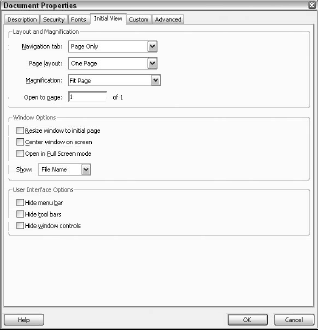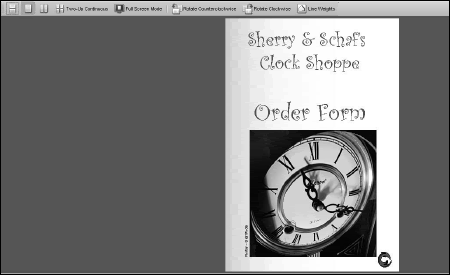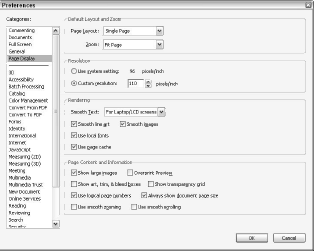Setting Initial View Attributes
Initial View is the page view you see when you first open a PDF document. You can set several different attributes for an opening view and you can save your settings with the document. These views are document specific so they only relate to a document where you save the settings. When no settings have been saved with a file, the file is saved with a default view.
Coincidentally, even though previous versions of Acrobat provided you with options to save an initial view, most PDF authors rarely use them. You can find thousands of PDF files on the Internet and most of them have no settings enabled for an opening view other than the program defaults.
To set the attributes for the opening view, choose File >> Properties or use the keyboard shortcut Ctrl+D. The Document Properties dialog box opens, displaying a row of tabs at the top. Click the Initial View tab as shown in Figure below.
Initial View settings are not available nor can they be changed in Adobe Reader even when usage rights have been added to the PDF. When Initial Views are saved from Acrobat Standard or Professional, PDFs open with the saved views in all Acrobat viewers.
Acrobat provides you with many different choices for controlling the initial view of a PDF opened in any Acrobat viewer. Settings you make on the Initial View tab can be saved with your document. When you establish settings other than defaults, the settings saved with the file override the user’s default preference settings. The options on this tab are as follows:
- Layout and Magnification. The default opening page is the first page of a PDF document. You can change the opening page to another page and you can control the page layout views and magnification by selecting choices from the Layout and Magnification section. The choices include:
- Navigation panel. Five choices are available from the Navigation panel pull-down menu. Select Page Only to open the page with the Navigation panel collapsed. Use the Bookmarks Panel and Page option to open the Bookmarks panel when the file opens.
Use the Pages Panel and Page option to open the Pages panel where the thumbnails of pages are viewed. Use Attachments Panel and Page to open the Attachments panel when the file opens, and Use Layers Panel and Page to open the Layers panel when the file opens.
- Page Layout. The default for Page Layout is noted in the pull-down menu as Default. When you save a PDF file with the Default selection, the PDF opens according to the default value a user has set for page viewing on the user’s computer. To override the user’s default, you can set a page layout in the opening view from one of six choices. Your options include:
Single Page. This option opens a single page view that appears the same as when you click the Single Page layout tool.
Single Page Continuous. The same as the Continuous page layout view in earlier versions of Acrobat. This view appears the same as when you click the Single Page Continuous tool.
Two-Up (Facing). The Two Pages (Facing) view shows the first two pages in a file beside each other in a two-page layout. When you scroll, subsequent pages snap to a page view. This view is the same as clicking the Two-Up tool.
Two-Up Continuous (Facing). The view appears very similar to Two-Up (Facing) but when you scroll pages, partial pages can be viewed in the Document pane. For example, the bottom of the previous page and the top of the next page may appear. In other words, this view doesn’t snap pages to fit in the Document pane.
Two-Up (Cover Page). The initial view shows one page as in the Single Page view. When you scroll pages, however, the subsequent pages are displayed in a Two-Up (facing pages) view.
Two-Up Continuous (Cover Page). The initial page opens on the right side of the Document pane in a Single Page view. When you scroll pages, the scrolling is similar to the Two-Up Continuous view where facing pages are shown.
- Magnification. Choose from preset magnification views in the pull-down menu. If you want the PDF document to open in a fit-in-window view, select Fit Page. Choose from other magnification options or edit the text box for a custom-zoom level. If Default is selected, the document opens according to user preference magnification settings.
- Open to page. You can change the opening page to another page by entering a number in the Page number text box. This setting might be used if you want a user to see a contents page on page 2 in a document instead of a title page that appears on page 1.
- Window Options. The default window for Acrobat is a full screen where the viewing area is maximized to occupy your monitor surface area. You can change the window view to size down the window to the initial page size, center a smaller window onscreen, and open a file in Full Screen mode. If you enable all three check boxes, the Full Screen mode prevails.
- Show. From the pull-down menu choose either File Name or Document Title. If you select File Name, the title bar at the top of the Acrobat window shows the filename. If Document Title is used, the information you supply in the Document Properties dialog box for Document Title is shown in the title bar
- User Interface Options. The Interface Options in the Initial View Document Properties dialog box have to do with user interface items in Acrobat viewers, such as menu bars, toolbars, and scroll bars. You can elect to hide these items when the PDF document opens in any Acrobat viewer.
You can hide any one or a combination of the three items listed under the User Interface Options. If you elect to save files without any of the user interface items in view, then creating navigational buttons so users can move around your document is a good idea.
The window controls you see in Figure below include the scroll bars, the status bar, and the Navigation panel. If you hide the toolbars and menu bar but elect to leave the window controls visible, users can access tools for page navigation.
If you don’t assign Initial View attributes in the Document Properties dialog box and save the file to update it, initial views are determined from individual user preferences. Because each user can set preferences differently, the same PDF may appear with a different page layout mode and a different zoom level on different computers.
Depending on the design of your documents and how you want them viewed by end users, potential inconsistency in document views might make viewing difficult for those who view your files. Users set initial view preferences in the Preferences dialog box.
Open the Preferences dialog box by pressing Ctrl+K, and then click Page Display in the left pane. At the top of the right pane, a pull-down menu appears for Default page layout; at the bottom of the right pane another menu appears for Default zoom. You can select different page layout and default zoom views from the menus.
In Figure below, the Default page layout view is set to Single Page and the Default zoom is set to Fit Page. When you click OK to accept these changes, all PDF documents that have initial views set to Default will open on your computer with the views derived from your preference choices.
Other users may choose different options from the pull-down menus, thereby displaying PDF documents with default views according to the choices they make in the Page Display preferences.
Be aware that the initial views you set in a PDF file from the Document Properties override the user preferences in the Page Display preferences pane. Therefore, you can control the initial views for all the PDFs you create. Doing so means your documents are viewed consistently across all computers regardless of the differences between individual user preference choices.
When you decide what view attributes you want assigned to your document, you can choose one of two save options. The first option updates the file. Click the Save tool in the Acrobat File toolbar or choose File >> Save. Any edits you make in the Initial View properties activates the Save command.
The Save command is inactive and grayed out by default until you make any changes to your file or reset any kind of preferences that can be saved with the document. The other option is to use Save As. When you select File >> Save As, you completely rewrite the file when you click the Save button in the Save As dialog box.


